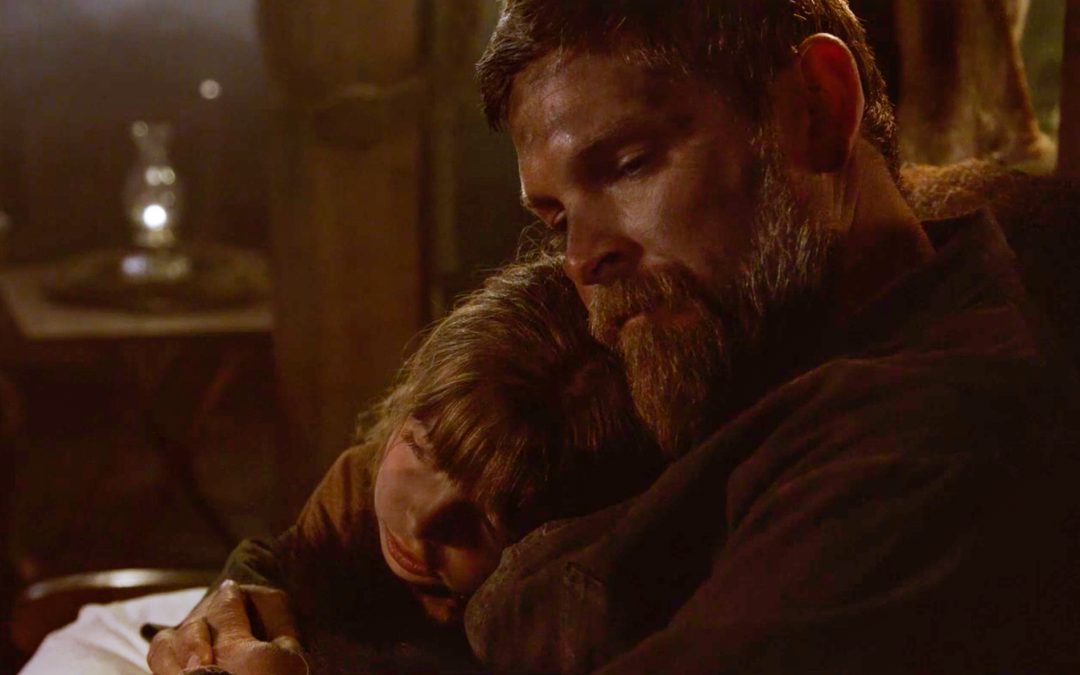Brian Presley is director and star of a thrilling true-life drama set in 1925 Alaska.
Leonhard Seppala journeyed to Nome, Alaska to be a gold miner, and wound up becoming a legend.
In the world according to The Great Alaskan Race, the beautifully filmed and dramatically gripping fact-based movie opening Friday, Oct. 25, in limited theatrical release, Seppala (played by writer-director Brian Presley) becomes a champion dog musher when he isn’t searching for gold. More important, he also becomes a dedicated family man: He falls for a local Inuit woman, Kiana (Talliah Agdeppa); they marry and have a daughter, Sigrid. But when Kiana passes away soon after childbirth, Seppala is shattered, and remains grief-stricken for years. And although he continues to compete as a musher in many races, he maintains his distance from most other folks in the Nome community, warming only toward Sigrid.
Then, in the winter of 1925, a diphtheria outbreak hits Nome during a horrible blizzard, and Dr. Welch (Treat Williams), operator of the local hospital, realizes he doesn’t have any of the medicine necessary to treat the dread disease, and the whole town is at risk. Because the storm is too intense for trains or planes to make it through, Seppala, along with several other brave mushers, volunteer to brave the unforgiving elements with their dogs to travel 674 miles to where the antitoxin serum is stuck in Nenana. While Gov. Scott Bone (Bruce Davison) anxiously monitors the situation from Juneau, and radio newscaster Harry Davenport (Nolan North) keeps the world updated with virtually nonstop coverage, Seppala sets out with his lead dog Togo and the rest of his team on a race again time — a race that becomes a personal crusade when Sigrid joins those hospitalized under Dr. Welch’s care.
The Great Alaskan Race is the first indie feature to be written, produced and directed by Brian Presley, a Midland, Texas native whose resume as an actor also includes such credits as Home of the Brave (with Samuel L. Jackson and Jessica Biel), Touchback (with Kurt Russell, Melanie Lynskey and Christine Lahti) and USS Indianapolis: Men of Courage (with Nicolas Cage and Tom Sizemore). Evidently, he enjoyed the multiple challenges of working on both sides of the camera: He’s currently in post-production on his next project as a multi-hyphenate — The Orphan Train, a post-Civil War drama due for release next year.
Presley recently spoke with us about his experiences while wearing many hats and dashing through the snow for The Great Alaskan Race. Here are some highlights from our conversation, edited for brevity and clarity.
Cowboys & Indians: What drew you to this remarkable story in the first place?
Brian Presley: A friend of mine told me this story years ago, and said, “God, I can’t believe this has not been made into a movie.” And the more I began to research the story, I thought, “God, you’re right. This is a dog saving a kid’s life, and it’s a true story.” This is one I believe five-year-olds and 95-year-olds can enjoy. For me, the challenge going in was figuring out how I wanted to go about telling the story.
C&I: Of course, it’s not just about a heroic dog. It’s also about, among other things, your character — Leonhard Seppala, the musher who steps up in the middle of the diphtheria outbreak for what came to be known as “The Great Serum Run.”
Presley: Well, I have to admit, I like watching character-driven pieces. I like watching people overcome unimaginable obstacles in their life. We’re all flawed in some way, and I think it’s fascinating to watch a man who loses everything, or so he thinks, and overcomes tragedy, and then gets dealt with a potential round two. The human will, and the human spirit, and the fight to survive — that’s pretty powerful stuff. I just chose to tell the story from a multi-character point of view. I wanted it to have an ensemble feel. I didn’t want it to be just about Leonhard Seppala. The story’s from his point of view, but I also wanted to bring in the governor, who’s played by Bruce Davison. And the guy’s who’s pushing to use airplanes, played by Henry Thomas.
C&I: And the local doctor played by Treat Williams. And the doctor’s daughter and assistant, played by Brea Bee.
Presley: Exactly. All these elements, the whole town of Nome. And how everybody began to rally together. My goal was to try and tie all the stories in around this event, but keep it character-driven.
C&I: Why did you choose Silverton, Colorado for a filming location?
Presley: Finding a place that had period resources for me was the hardest challenge. And also, a place where you were in the elements — where we had the snow, and the snow level. Silverton, Colorado was perfect in every way. They have a big mining museum. They literally opened the door for us to make this movie. We couldn’t have made it without the local people. We were there in January through March, and the town’s a pretty quiet place in those months, and so we had the full range of everything. It all kind of came together.
C&I: Did you ever have days when the weather wasn’t bad enough?
Presley: [Laughs] Mostly, what you see on the screen is what we shot. It’s the real deal. There were some night shoots when, literally, I’d crawl myself back to my hotel and crawl myself in a hot bath, and it would be hard to get out. I mean, it was cold. The elements, we were in them. But then there also were days where we’d go to finish certain scenes, or we’d go do mushing scenes — and the sun was out. Actually, it wound up taking me about four months to color correct the movie, to make sure everything matched. You see, in this movie, the storm is a character. The elements are characters. And I wanted the storm to mirror the disease back in the hospital. When you have a snow storm in weather that cold, it’s suffocating. Just like the disease, the diphtheria. And as time’s running out, I wanted what was happening [to Seppala] in that storm to mirror what was happening to people suffering from the disease in our hospital.
C&I: You cast your own young daughter, Emma Presley, to play Sigrid, Seppala’s daughter, in The Great Alaskan Race. Were you at all concerned about introducing her to show business at an early age?
Presley: A bit. I mean, it’s important for kids to be able to go be kids. For them to go off for a couple of weeks and have an experience like this — well, in this case, it’s something I’m controlling. I’m not here to judge anybody else who lets their kids be in this business. I mean, I would let them go do it with another director if I trusted who it was. On the other hand, I probably wouldn’t let my kids go be on a TV series for six months at a time. But to do it in small doses here and there while they’re young, and they have an interest in it — and they get exposed to how it all works in the business I’m in — for me, I think I’m fine with that. Life is all about experiences.
C&I: Would you say your movie is, on some levels, a western? And not just because we see you and other people on horseback?
Presley: Definitely. I mean, The Great Race is kind of a western in the snow. And my next one, The Orphan Train, definitely has that western genre feel. I’m on a horseback the entire movie. One of the things that I do with all of my stuff is, I do my own riding. I do all my own stunts. Like, I was on the dog sled in this one. [Laughs] And there were times I fell off the dog sled. Just like there were times in Orphan Train, where we have big Civil War battles scenes, where I’d fall off my horse. But I’d come up firing.
C&I: After establishing yourself as an actor, and appearing alongside folks like Kurt Russell, Samuel L. Jackson and Nicolas Cage, you’ve recently branched out to become a multitasker — writing, producing and directing. Do you see this as a way of taking greater control of your destiny?
Presley: Well, back when I did Home of the Brave, I was competing for that role with Channing Tatum, and Ryan Philippe, and Paul Walker. We were all up against each other. And I remember when I got it, I thought, “Okay, I’ve finally arrived.” Then the movie went to where it hardly even got released. So what I’ve learned in this business is, you can’t compare your path to other people’s paths. Sure, I would have loved to have had some of my movies hit big at the box office, and then go off to the bigger movies. But that hasn’t been my path. My path has been to kind of claw my way up the mountain. I write, direct, edit, produce, and act. The Great Alaskan Race is kind of my introduction as a filmmaker, and as a storyteller. We have recently now launched my own distribution company, which is P12 films, and we’re climbing the mountain. I believe life is like climbing a mountain. We’re all climbing mountains in our life. Sometimes we get knocked back down, and we got to get back up and keep going.
C&I: Did you ever worry whether that you’d bitten off more than you could chew?
Presley: Not really. I’d already produced some movies, and been able to shadow certain directors, throughout my career. It’s like Kurt Russell told me when I worked with him on Touchback: “If you see it in your head, you should be the one to tell the story.” That doesn’t always happen, I know. But I had this movie in my head, and I knew the challenges. I had everybody in town tell me, “There’s no way you’re ever going to get this movie made. There’s no way you can do it for an independent price. There’s no way anybody’s going to sign off on a first-time director directing dogs and kids in these kind of elements. You at least need six to eight weeks of dog training, and you need this, and you need that.” But that’s Hollywood. Everywhere you go in Hollywood, people love to tell you why you can’t do things. For me, I love being the underdog, and overcoming the odds. Which is what I love about playing the character of Leonhard Seppala: It’s an underdog story.
_____________

